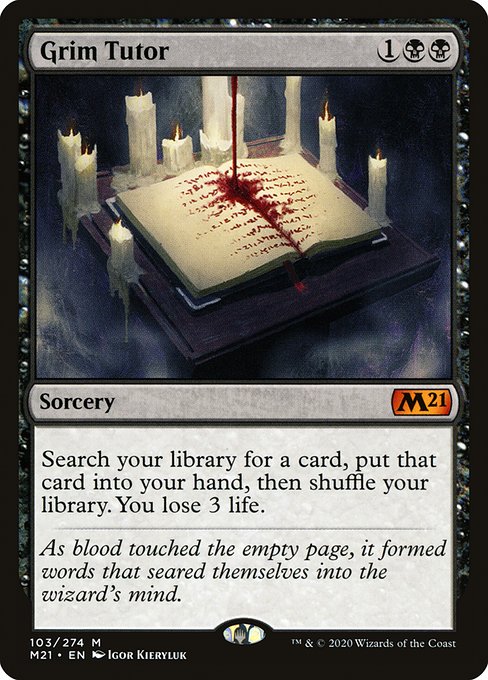
Image courtesy of Scryfall.com
Mutual humor, enduring community: how Grim Tutor anchors a lively MTG culture
Magic: The Gathering isn’t just a game of spells and numbers; it’s a shared ritual where friends, strangers, and longtime rivals come together to swap stories, memes, and battlefield misfires. In communities around the world, humor has become a quiet backbone—a way to weather the losses, celebrate the wins, and keep the conversation alive after the last conflict of the night. And in that vein, the mythic pivot of Grim Tutor stands out as a perfect metaphor: a card that promises powerful library access at the cost of a few precious life points. It’s a reminder that in MTG as in life, knowledge is valuable, but it often comes with a price tag—and a punchline. 🧙♂️🔥
Grim Tutor, a black sorcery from Core Set 2021, costs {1}{B}{B} for a 3-mana tutor that rewards the patient, strategic mind. Its oracle text—“Search your library for a card, put that card into your hand, then shuffle. You lose 3 life.”—is elegantly simple and criminally potent. In commander circles, modern-borne control builds, and even in casual kitchen-table play, the card rewards careful sequencing and risk assessment. The flavor text—“As blood touched the empty page, it formed words that seared themselves into the wizard's mind.”—reads like a micro-essay on the courage it takes to pay for clarity. The art by Igor Kieryluk captures that same tension: a hush before action, a silhouette of power about to be unleashed. ⚔️
What makes Grim Tutor a community beacon isn’t just its power level; it’s the way players lean on it for shared storytelling. The decision to pay 3 life for a single tutor mirrors the social decision to sacrifice a little comfort for a big payoff—whether you’re downtempo bluffing through a political game, or quietly hoarding value for a massive next-turn swing. That tension becomes fuel for jokes, memes, and learning moments, a rare combination that makes a group feel resilient even when the match looks grim. In practice, players joke about “paying life for knowledge,” turning a potential curse into a running gag that colors every tutoring turn with a wink. 🧠💎
The cards, the culture, and the craft
Design-wise, Grim Tutor underscores a core truth of MTG: variety in card mechanics invites a diversity of strategies. A modern or legacy table might lean on the certainty of a reliable tutor, while a commander pod could pivot toward political theater and dramatic reveals. The card’s color identity (black) and its status as a mythic rare emphasize its role as a coveted piece—one that players often debate in forums, streams, and local meta chats. Its presence in the set as a reprint also adds a whisper of nostalgia: a card that has seen play in multiple forms across the years, now present again with a new generation of fans appreciating the elegant cost-to-value ratio. And while you’ll never see Grim Tutor in a 1v1 Standard grind, its impact ripples outward, inspiring deck builders to choreograph their turns with surgical precision. The EDH/Commander crowd, in particular, values that reliability—the ability to fetch a finisher, a catalyst, or a necessary answer from the library and continue the dance with a sharpened edge. This is where humor and resilience fuse: players console one another after misreads, celebrate a perfectly timed tutor, and riff about the life-pay being worth it for the required piece. 🧙♂️🎲
From a collector’s vantage, Grim Tutor’s status as a M21 mythic adds another layer to the social fabric. The card comes in foil and nonfoil variants, with the market reacting to print runs, demand in a SR-type meta, and the general fever of mythic status. The EDHREC ranking caveat—the 651st spot—offers a quiet counterpoint: these are not “must-take-the-table” staples for every list, but they are manifestly present enough to be talked about, memed, and traded. In a way, that steady presence mirrors the longer arc of community resilience: you don’t need every moment to be a blockbuster; you just need enough reliable, memorable moments to keep people coming back. And when the joke lands—“Grim Tutor? I’ll pay 3 life for a big swing”—it becomes a ritual, a small but meaningful shared experience that binds the table. 🔥
- Grim Tutor’s cost-and-effect pair encourages regulated risk-taking, a trait shared by many strong community leaders who model calculated courage. 🧙♂️
- The flavor text and art invite discussion about how power is earned and the price that comes with hard-won knowledge. 💎
- As a core-set reprint, it sparks conversations about card history and the evolution of tutor effects across formats. 🎨
- Its presence in Commander means stories of big turns, clutch draws, and life-pay gambits become social currency at table nights. ⚔️
- Humor acts as the glue: memes about tutoring on your own turn, saving your life, or paying life for “one more draw” become shared language. 🎲
We see this dynamic echoed beyond the battlefield as fans connect around helpful content and design philosophies. The five linked articles below are a reminder that strategic thinking and playful experimentation go hand in hand—whether you’re weighing the merits of a powerful draw engine, optimizing a subgame state, or crafting a better daily routine for peak focus. The MTG community proves time and again that resilience is a social artifact as much as a card-slinging skill. 🧙♂️🔥
Product spotlight
While you strategize, protect your everyday carry with style. Consider this sleek accessory that suits the modern gamer on the go:
Slim Phone Case for iPhone 16 – Glossy Lexan Ultra-Thin
More from our network
- https://crypto-acolytes.xyz/blog/post/slay-the-spire-vs-monster-train-which-card-building-game-reigns/
- https://blog.digital-vault.xyz/blog/post/rigging-runner-mastering-board-state-with-subtle-tricks/
- https://blog.digital-vault.xyz/blog/post/designing-notion-daily-routine-templates-for-peak-productivity/
- https://blog.digital-vault.xyz/blog/post/cosplay-storm-recreating-earthshaker-giant-in-mtg-style/
- https://blog.digital-vault.xyz/blog/post/kav-landseeker-keyword-abilities-a-side-by-side-strategy-guide/